Leibniz’s Rule: Generalization of the Product Rule for Derivatives
In this video I go over Leibniz’s rule which is the generalization of the product rule for derivatives and extends it for all derivatives and not just the first one. I had covered the product rule in my earlier video and showed that the derivative of the product (f·g)’ = f’g + fg’. We can use this same product rule, along with mathematical induction, to prove the general Leibniz rule for the n-th derivative of the product (f·g) (n).
Leibniz’s rule makes use of the binomial coefficient which I had briefly discussed in a prior video as well. After I prove the rule, I manually derive consecutive derivatives using the product rule, as well as comparing the result with the binomial theorem. I do this to show the amazing synchronicity or similarity between the powers of a binomial (x + y)n and the derivative of a product (f·g) (n).
The topics covered in this video are listed below with their time stamps.
- @ 0:42 - Topics to Cover
- @ 1:14 - Recap on the Product Rule for Derivatives
- @ 2:51 - Leibniz's Rule: Generalization of the Product Rule for Derivatives
- @ 8:00 - Proof of Leibniz's Rule
- @ 45:17 - Manually Determining the n-th Derivative Using the Product Rule
- @ 59:27 - Synchronicity with the Binomial Theorem
Watch video on:
- 3Speak: https://3speak.tv/watch?v=mes/ybaefwxz
- Odysee: https://odysee.com/@mes:8/leibniz-s-rule-generalization-of-the:3
- BitChute: https://www.bitchute.com/video/s7zX3Nba9L2Y/
- Rumble: https://rumble.com/v1tch8w-leibnizs-rule-generalization-of-the-product-rule-for-derivatives.html
- DTube: https://d.tube/#!/v/mes/2quoj9uttg6
- YouTube: https://youtu.be/Yjvws01zqzU
Download Video Notes: https://1drv.ms/b/s!As32ynv0LoaIiLYb3IimifHz3HfzeQ?e=rch7UF
View Video Notes Below!
Download these notes: Link is in video description.
View these notes as an article: https://peakd.com/@mes
Subscribe via email: http://mes.fm/subscribe
Donate! :) https://mes.fm/donateReuse of my videos:
- Feel free to make use of / re-upload / monetize my videos as long as you provide a link to the original video.
Fight back against censorship:
- Bookmark sites/channels/accounts and check periodically
- Remember to always archive website pages in case they get deleted/changed.
Join my private Discord chat room: https://mes.fm/chatroom
Check out my Reddit and Voat math forums:
Buy "Where Did The Towers Go?" by Dr. Judy Wood: https://mes.fm/judywoodbook
Follow along my epic video series:
- #MESScience: https://mes.fm/science-playlist
- #MESExperiments: https://peakd.com/mesexperiments/@mes/list
- #AntiGravity: https://peakd.com/antigravity/@mes/series
-- See Part 6 for my Self Appointed PhD and #MESDuality breakthrough concept!- #FreeEnergy: https://mes.fm/freeenergy-playlist
NOTE #1: If you don't have time to watch this whole video:
- Skip to the end for Summary and Conclusions (if available)
- Play this video at a faster speed.
-- TOP SECRET LIFE HACK: Your brain gets used to faster speed. (#Try2xSpeed)
-- Try 4X+ speed by browser extensions or modifying source code.
-- Browser extension recommendation: https://mes.fm/videospeed-extension
-- See my tutorial to learn more: https://peakd.com/video/@mes/play-videos-at-faster-or-slower-speeds-on-any-website- Download and read video notes.
- Read notes on the Hive blockchain #Hive
- Watch the video in parts.
NOTE #2: If video volume is too low at any part of the video:
- Download this browser extension recommendation: https://mes.fm/volume-extension
Leibniz's Rule: Generalization of the Product Rule for Derivatives
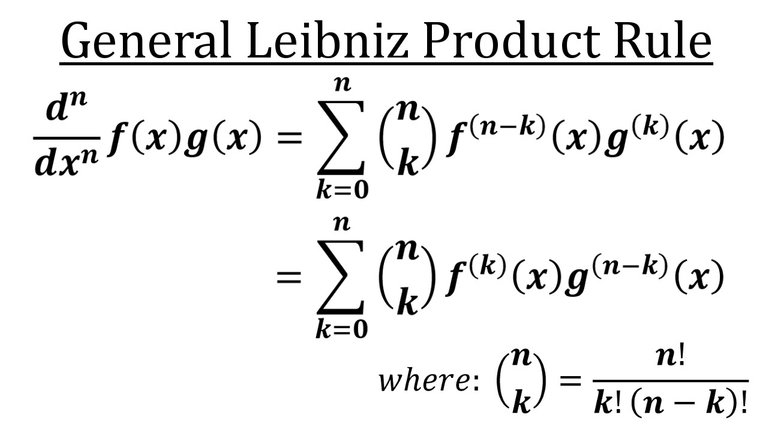
Topics to Cover
- Recap on the Product Rule for Derivatives
- Leibniz's Rule: Generalization of the Product Rule for Derivatives
- Proof of Leibniz's Rule
- Manually Determining the n-th Derivative Using the Product Rule
- Synchronicity with the Binomial Theorem
Recap on the Product Rule for Derivatives
Recall from my earlier video in which I covered the product rule for derivatives.
Retrieved: 7 August 2020
Video notes archive: https://archive.vn/tbpU2

Note that we can also write the product rule in the following equivalent notation:
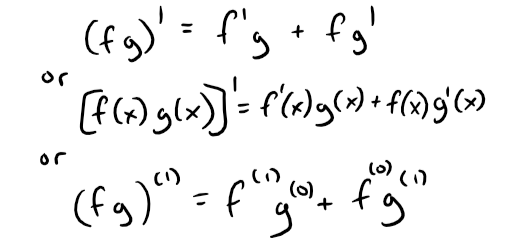
Leibniz's Rule: Generalization of the Product Rule for Derivatives
The following generalization of the product rule is known as the Leibniz's rule or general Leibniz rule, named after Gottfried Wilhelm Leibniz, and the proof is taken from Wikipedia:
https://en.wikipedia.org/wiki/General_Leibniz_rule
Retrieved: 8 August 2020
Archive: https://archive.vn/wip/c2TDzGeneral Leibniz Rule
In calculus, the general Leibniz rule,[1] named after Gottfried Wilhelm Leibniz, generalizes the product rule (which is also known as "Leibniz's rule"). It states that if f and g are n-times differentiable functions, then the product f·g is also n-times differentiable and its n-th derivative is given by

where

is the binomial coefficient and f(j) denotes the j-th derivative of f (and in particular f(0) = f).
The rule can be proved by using the product rule and mathematical induction.
Note again the different equivalent derivative notations.

Thus we can write Leibniz's rule in the more formal derivative notation as well as in an equivalent alternative form.
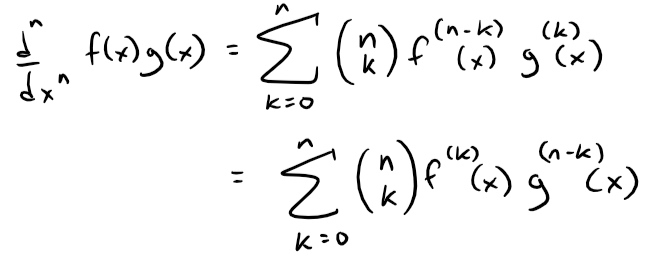
Proof of Leibniz's Rule
The proof involves the principle of mathematical induction, referenced from my earlier video.
Retrieved: 2 July 2019
Archive: http://archive.fo/4lslc
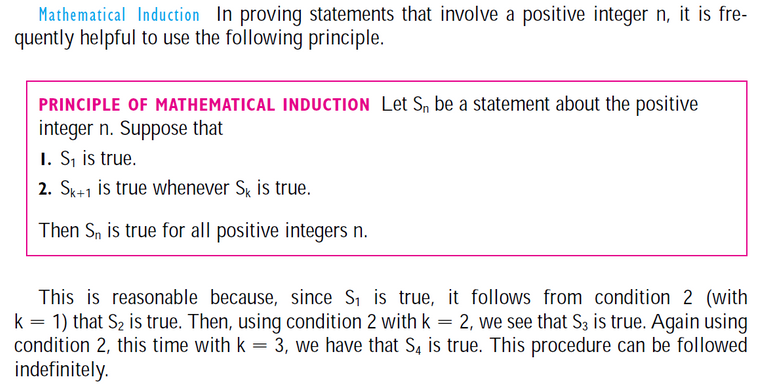
When n = 1, the Leibniz Rule becomes just the product rule for derivatives.

Note that 0! is defined as equal to 1.
Thus we know that the Leibniz' rule is true for n = 1, i.e. the product rule.
Let's assume it is true for a fixed n-th derivative where n ≥ 1:

The next step in mathematical induction is to prove it is true for n + 1 which we will do so using the product rule.
Thus, taking the derivative we have:

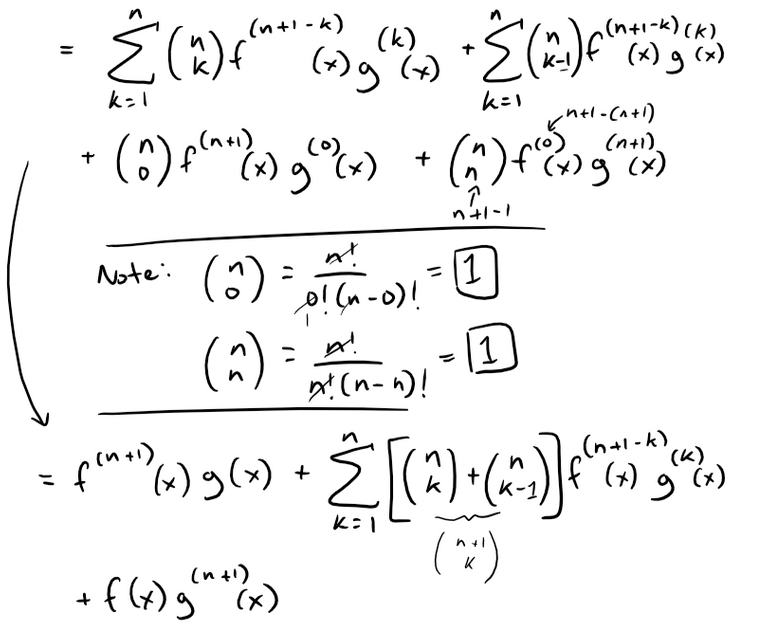
Note we can simplify the binomial coefficients by expanding and adding together.

Thus, we can continue simplifying our derivative.
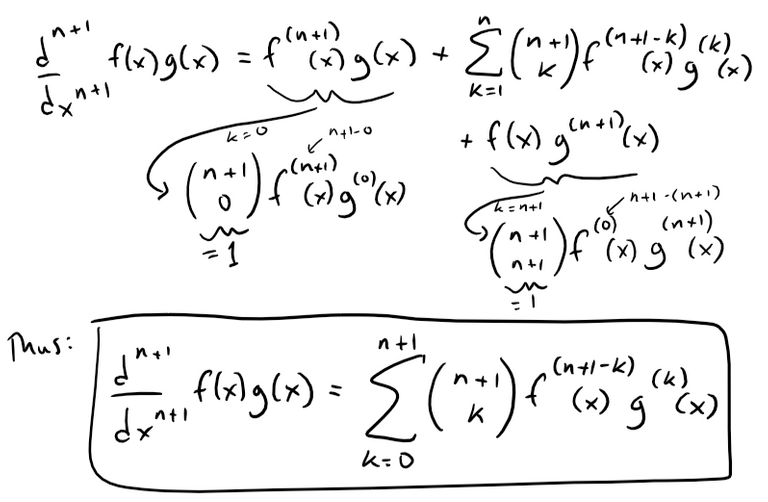
This is the result if we had just used Leibniz's rule and replaced n with n + 1.
Thus, our mathematical induction is complete and Leibniz's rule is true for all derivatives or for all n ≥ 1.
Manually Determining the n-th Derivative Using the Product Rule
We can see the pattern that arises when we manually derive the consecutive derivatives of the product of functions f and g.
Note that I will be using the short form derivative notation:
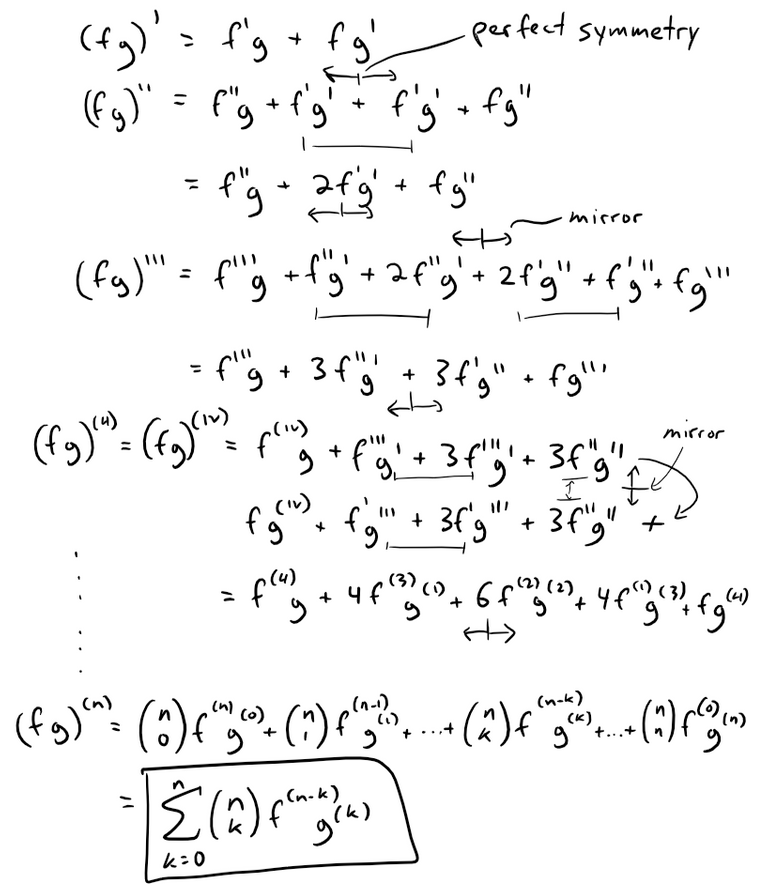
The pattern extends as expected based on Leibniz's rule.
Synchronicity with the Binomial Theorem
The Leibniz's rule is almost identical in appearance with the binomial theorem.
The binomial theorem involves the n-th power of a binomial (which is sum of two monomials or single termed polynomials) while Leibniz's rule involves the n-th derivative of a product of two functions.
And the binomial coefficients (or Leibniz's rule coefficients) can be determined easily by using Pascal's triangle as explained in my earlier video.
https://peakd.com/@mes/infinite-sequences-and-series-representations-of-functions-as-power-series
Retrieved: 6 August 2020
Archive: https://archive.vn/wip/JsH4lhttps://en.wikipedia.org/wiki/Binomial_theorem
Retrieved: 26 December 2019
Archive: https://archive.ph/7hDUVBinomial theorem
In elementary algebra, the **binomial theorem **(or binomial expansion) describes the algebraic expansion of powers of a binomial. According to the theorem, it is possible to expand the polynomial (x + y)n into a sum involving terms of the form axbyc, where the exponents b and c are nonnegative integers with b + c = n, and the coefficient a of each term is a specific positive integer depending on n and b. For example (for n = 4),

The coefficient a in the term of axbyc is known as the binomial coefficient:

(the two have the same value). These coefficients for varying n and b can be arranged to form Pascal's triangle. These numbers also arise in combinatorics, where (nb) gives the number of different combinations of b elements that can be chosen from an n-element set. Therefore (nb) is often pronounced as "n choose b".

The binomial coefficient (nb) appears as the bth entry in the nth row of Pascal's triangle (counting starts at 0). Each entry is the sum of the two above it.
…

…

…

MES Note: Note the symmetry in the formula and terms.
As a comparison we have:
